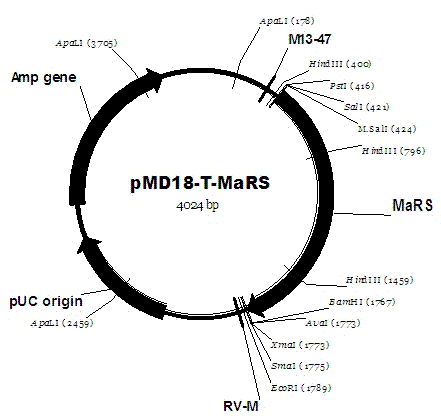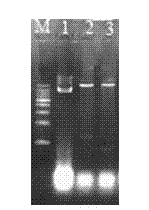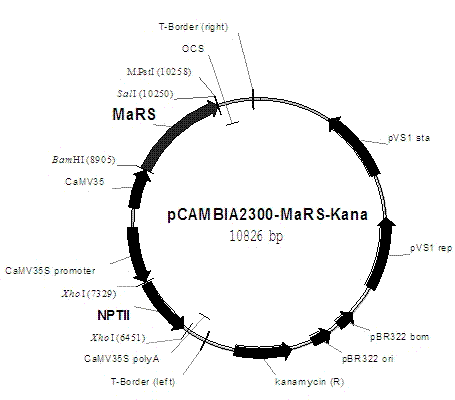Cloning of mulberry resveratrol synthase gene and construction of plant expression vector
A technology for resveratrol and synthase, which is applied in plant products, botanical equipment and methods, angiosperms/flowering plants, etc., and can solve problems such as unseen and cloned resveratrol synthase genes
- Summary
- Abstract
- Description
- Claims
- Application Information
AI Technical Summary
Problems solved by technology
Method used
Image
Examples
Embodiment 1
[0047] Mulberry total RNA extraction
[0048] Add 700 μL CTAB lysate [0.1mol / L Tris-Cl (pH8.0), 1.4mol / L NaCl, 0.05mol / L EDTA, 2g / 100mL CTAB, 2g / 100mL PVP] to 100mg of mulberries after liquid nitrogen grinding, vortex After vortexing and mixing, place in a 60°C water bath for 30 minutes; add an equal volume of chloroform, shake and mix, and centrifuge at 12,000 rpm for 10 minutes at room temperature, and take the supernatant; add 1 / 4 volume of 10mol / L LiCl, place for 30 minutes, and centrifuge at 12,000 rpm for 10 minutes. Discard the supernatant; add 1 mL of 75% ethanol to rinse the precipitate, centrifuge at 12,000 rpm for 5 min, discard the supernatant; add appropriate amount of DEPC-treated water to dissolve RNA after natural drying.
Embodiment 2
[0050] Mulberry resveratrol synthase gene ( MRS ) central conserved region clone
[0051] Take 1 μg of total RNA, use Random hexamer as a primer, and follow the instructions of RevertAidTM H Minus First Strand cDNA Synthesis kit to reverse transcribe to generate first-strand cDNA.
[0052] A pair of primers were designed according to the conservation of the stilbene synthase gene sequences of plants such as grapes, peanuts, and Polygonum cuspidatum, as shown in the sequence table: SEQ ID NO.1: SP1 5' AGGCAATCAAAGAGTGGGG 3' and SEQ ID NO.2: SP2 5' TGAGCAATCCAAAATATTGAGTT 3'.
[0053] The PCR reaction was carried out in a 25mL system containing 1×Dream Buffer (with 2mmol / L MgCl 2 ), 200μmol / L dNTP, 0.5mmol / L primer, 2U Dream Taq DNA polymerase, 1 mL first-strand cDNA. The PCR cycle was pre-denaturation at 95°C for 5 min; followed by 30 cycles, each cycle of denaturation at 95°C for 30 s, annealing at 55°C for 30 s, and extension at 72°C for 60 s; finally, full extension at...
Embodiment 3
[0061] Mulberry resveratrol synthase gene ( MRS ) 3′ RACE
[0062] The nested primers for 3'RACE were designed according to the sequence of the central conserved region, as shown in the list: SEQ ID NO.3: SP3 5' CGCTGATGGTGGGTCGGCTGTA3' and SEQ ID NO.4: SP4 5' GATGAGGGCTCCGCCGAAAGAC 3'.
[0063] The reverse transcription reaction system and reaction conditions were operated according to the instructions of 3′-Full RACE Core Set Ver.2.0. The first round of PCR was carried out with SP1 and the 3'RACE Outer Primer of the kit, and the second round of PCR was carried out with SP2 and the 3'RACE Inner Primer of the kit. After TA cloning of the amplified products, at least 3 to 5 clones were selected for sequencing.
PUM
 Login to View More
Login to View More Abstract
Description
Claims
Application Information
 Login to View More
Login to View More - R&D
- Intellectual Property
- Life Sciences
- Materials
- Tech Scout
- Unparalleled Data Quality
- Higher Quality Content
- 60% Fewer Hallucinations
Browse by: Latest US Patents, China's latest patents, Technical Efficacy Thesaurus, Application Domain, Technology Topic, Popular Technical Reports.
© 2025 PatSnap. All rights reserved.Legal|Privacy policy|Modern Slavery Act Transparency Statement|Sitemap|About US| Contact US: help@patsnap.com



